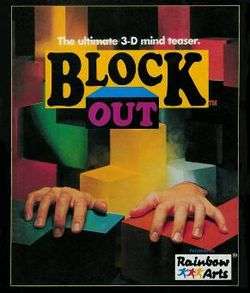Blockout
| Blockout | |
|---|---|
 | |
| Developer(s) | California Dreams |
| Publisher(s) |
California Dreams (computer versions) American Technos (arcade version) |
| Designer(s) | Aleksander Ustaszewski, Mirosław Zabłocki |
| Platform(s) | Arcade, Mega Drive/Genesis, Commodore 64, Amiga, PC, Atari Lynx, Atari ST, Apple IIGS, Macintosh, Linux NES / Unreleased |
| Release date(s) |
Arcade version: Mega Drive/Genesis‹See Tfd›
‹See Tfd›
‹See Tfd›
|
| Genre(s) | Puzzle |
| Mode(s) | Single-player, multiplayer |
Blockout is a puzzle video game, published in 1989 by California Dreams, developed in Poland by Aleksander Ustaszewski[1] and Mirosław Zabłocki.
.png)
The game is the logical extension of Tetris into the third dimension. In regular Tetris, the player manipulates a set of tetrominoes which fall into a two-dimensional pit (seen from the side). The aim is to solve a real-time packing problem by forming complete rows, which then disappear and score points. Poor play leads to incomplete rows, caused by inefficient arrangements of tiles; these rows do not disappear, giving the player progressively less space and less time to play subsequent pieces. Similarly, in Blockout, the player manipulates a set of polycubes which fall into a three-dimensional pit (seen from above; the pieces appear in the foreground and fall away). The pieces can be rotated around all three axes, and moved horizontally and vertically. The aim is to form complete layers.
Reception
| Reception | ||||||||||
|---|---|---|---|---|---|---|---|---|---|---|
| ||||||||||
| ||||||||||
The New York Times reviewed the game in an article about educational software for mathematics, writing that Blockout "doesn't pretend to be educational, but the skills required to master it are not unrelated to mathematics, particularly geometry."[1] A 1993 study found evidence that playing Blockout improved the spatial visualization ability of 10- to 14-year-olds.[5] Dragon gave the game's Atari Lynx version a perfect score.[6]
References
- 1 2 L. R. Shannon: No-Frills Mathematics Instruction The New York Times, 23 January 1990
- ↑ MegaTech rating, EMAP, issue 6, page 76, June 1992
- ↑ Mega rating, issue 9, page 23, Future Publishing, June 1993
- ↑ Garth Sumpter (November 1990). "Blockout". PC Leisure (journal). EMAP (3): 62.
- ↑ NOSS, A. (1994): Förderung der Raumvorstellung bei 10- bis 14-Jährigen durch das Computerspiel BLOCKOUT. Diploma thesis, University of Vienna.
- ↑ Lesser, Hartley; Lesser, Patricia & Lesser, Kirk (May 1992). "The Role of Computers". Dragon (181): 57–62.